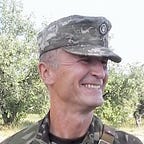Evolution of the nation: a view from the Ukrainian Wikipedia during the war
The history of the transformation of the societal attitudes of Ukrainians along 2 years, condensed into a 6-minute animation. You will love it.
How to objectively measure the changes in public attitudes of Ukrainians as a result of the war waged by the russian federation against Ukraine?
In search of an objective and statistically significant source that would reflect the public mood of Ukrainians over time, we turned our attention to the Telegram channel “My Wikipedia”. The channel positions itself as the publisher of a daily summary of the top 25 articles of the Ukrainian segment of Wikipedia (hereinafter — Top-25), photo of the day, as well as news of Ukrainian Wikipedia.
In the daily summary of the Top-25 in the channel, articles are arranged by the number of views per day and numbered accordingly (daily rating).
We designed and implemented, using Python, the following Top-25 analysis process for 2 years (from February 23, 2021 to February 25, 2023):
- automated reading of messages from the Telegram channel “My Wikipedia” (telethon package);
- filtering, elimination of data irregularities, creation of a database containing four main columns: article name, Top-25 date, daily rating (from 1 to 25) and number of views per day;
- all unique names of articles are translated into English (Translator module from the googletrans package);
- data preparation and video animation creation (bar_chart_race package);
- soundtracking, editing, publishing on YouTube.
To present the rating of articles in animation, we constructed our own indicator, the so-called reverse rating. The fact is that three indicators are obtained directly from the Top-25: the actual daily rating (from 1 to 25) and the daily number of views. One can also get the third indicator — the fact of entering the Top-25.
Each of these indicators has its own shortcomings. On the one hand, the daily rating, due to its discreteness, does not take into account the number of views. Also, it is not an additive value due to the presence of a special point — the value 0 (zero). On the other hand, the daily number of views is too volatile (stochastic) value, subject to significant random fluctuations. And, lastly, the fact of entering the Top-25 is too uninformative.
So, we took the inverse rating as a basis, as a value that is additive, reflects the fact of entry, and after summation (or averaging) reflects not only the fact of entry into the Top-25, but also the position in the rating.
A few details about preparing data for animation:
- article selection threshold: more than 15 hits in the Top-25 rating in 2 years;
- width of the floating time averaging window: 2 weeks;
- rating parameter in the presentation: the average value of the reverse rating for the averaging period (2 weeks).
For ease of presentation, the average reverse rating was multiplied by 1000.
Actually, this is all about the methods of our research. Now with the knowledge of the case, you can proceed to the animation watching.
Everyone will make their own conclusions from what they have viewed. However, this is already the topic of the next conversation — so write to us in the comments here on Medium or under the video on Youtube.
Authors of the publication (Youtube and Medium):
- Author of the idea, data preparation, producer: Oleg Bondarenko, https://protw.github.io/oleghbond/
- Animation: Maria Bovsunovska
- Sounding, editing: Inokentiy Horobtsov
- Soundtrack: Kris Keypovsky, “First armored” (BY 4.0 license)
- Managing editor: Yulia Khrystynchenko
- Also, many thanks to the colleagues who took part in the discussion of the title of the article: Hanna Kolomiets, Dmytro Ivanov, Oleksandr Gusiev, Vitaliy Gulevets, Yevhen Bovsunovskyi
